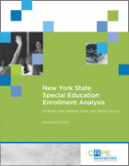 A widely-noted Government Accountability Office (GAO) report back in June found that charter schools serve a disproportionately low number of special-education students, feeding concerns that these schools discriminate again special-needs (and ELL) youngsters. This latest from the Center on Reinventing Public Education (CRPE) adds much-needed nuance and should quell some of the concern. CRPE analysts examined 2011-12 special-education enrollments across 1,500 district and 170 charter schools in New York State, finding that aggregates in that state mask important differences across grade band, location, and authorizer. At the middle and high school levels, New York special-education enrollments are nearly identical in the district and charter sectors, with the only variance—albeit sizable—occurring at the elementary level. (The authors offer a few suggestions as to why, including that charter elementaries are less likely to label students special-needs as they have more effective behavior-management systems, smaller classes, or a general insistence on “individualized” education for every pupil.) From these findings, the researchers draw cautionary policy recommendations, urging against the adoption (or continuation) of blanket special-education-enrollment requirements. (New York has such a law; more on this on our Choice Words blog). Not a bad first step, considering that such requirements often lead to over-identification of students as disabled. But let’s also recall the larger question: Why should a single school—charter or otherwise—be expected to appropriately serve all students?
A widely-noted Government Accountability Office (GAO) report back in June found that charter schools serve a disproportionately low number of special-education students, feeding concerns that these schools discriminate again special-needs (and ELL) youngsters. This latest from the Center on Reinventing Public Education (CRPE) adds much-needed nuance and should quell some of the concern. CRPE analysts examined 2011-12 special-education enrollments across 1,500 district and 170 charter schools in New York State, finding that aggregates in that state mask important differences across grade band, location, and authorizer. At the middle and high school levels, New York special-education enrollments are nearly identical in the district and charter sectors, with the only variance—albeit sizable—occurring at the elementary level. (The authors offer a few suggestions as to why, including that charter elementaries are less likely to label students special-needs as they have more effective behavior-management systems, smaller classes, or a general insistence on “individualized” education for every pupil.) From these findings, the researchers draw cautionary policy recommendations, urging against the adoption (or continuation) of blanket special-education-enrollment requirements. (New York has such a law; more on this on our Choice Words blog). Not a bad first step, considering that such requirements often lead to over-identification of students as disabled. But let’s also recall the larger question: Why should a single school—charter or otherwise—be expected to appropriately serve all students?
SOURCE
Robin Lake, Betheny Gross, and Patrick Denice, New York State Special Education Enrollment Analysis (Seattle, WA: Center on Reinventing Public Education, November 2012).
